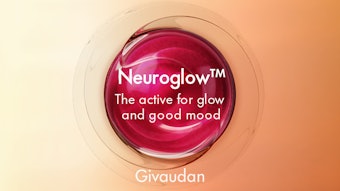
How does touch technology influence sun care formulation? With consumers continually tapping on their various touch screen devices to connect with others and information, many believe this interaction has heightened their sense of feel. This is causing consumers to seek new sensory experiences in all areas of their lives. With consumers searching for more advanced sensory experiences, increasingly sophisticated personal care formulations are required to meet this demand.
Up until now, the sunscreen industry had not been able to deliver the advanced feel that consumers were seeking in their formulations, especially those containing inorganic sunscreen filters. To answer this need, Croda has developed an inorganic sunscreen filter with truly sensational skin feel. Solaveil ST- 100 (INCI: C12-15 Alkyl Benzoate (and) Titanium Dioxide (and) Polyglyceryl-3 Polyricinoleate (and) Silica (and) Stearic Acid (and) Aminopropyl Triethoxysilane) is a uniquely coated titanium dioxide dispersion that combines optimum UV performance with enhanced aesthetics, enabling the formulation of sensationally light and luxurious UV protection products.
Featuring an innovative, patent pending, silane coating, Solaveil ST-100 offers excellent UVB protection as well as true transparency on the skin, due to its tightly controlled particle size distribution. As with Croda’s other TiO2 based dispersions, it offers excellent photostability for consistent UV performance and is mild and safe for use on children, babies and sensitive skin.
Silica for Skin Feel
Sensory optimized TiO2 dispersions typically rely on dimethicone coatings and silicone carrier oils to deliver an elegant skin feel. In contrast, Solaveil ST-100 employs a patented hydrated silica surface with a hydrophobically modified silane outer coating, as shown in Figure 1, to deliver a light and luxurious skin feel. This allows for the formulation of sophisticated sun care products without the need for silicone based dispersions.
In a sensory evaluation, Croda evaluated the feel characteristics of formulations containing Solaveil ST-100 versus Solaveil CT-100, using the Sensory Descriptive Analysis methodology (Sensory Spectrum Inc, New Providence, NJ, USA). This method involves extensive training for sensory evaluators that assess the sensory aspect of a product during the four sequential phases of product evaluation: appearance (e.g. shine), pick-up (e.g. firmness, cohesiveness) , rub-out (e.g. spreadability, wetness, absorbency), after-feel, both immediate and after 20 minutes (e.g. slipperiness, oil, wax, grease). Solaveil CT-100, from the Solaveil Clarus Range, was selected as a benchmark product, as it is also dispersed in C12-15 Alkyl Benzoate, like Solaveil ST-100. Both formulations have equal amounts of C12-15 Alkyl Benzoate and 7.6% solid TiO2.
The training is done relative to benchmarks on a 100-point scale, and the sensory evaluators are constantly monitored to check for deviations in their scoring of benchmark products. The benchmarks for the attributes in Figure 2 are Johnson & Johnson's Baby Oil (oil) and Procter & Gamble's Olay Active Hydrating Fluid (wax).
Figure 2 shows sensory panel scores for w/o formulations prepared with Solaveil ST-100 and Solaveil CT-100 dispersions (shown in the Table 1). While some sensory characteristics were similar, those that demonstrated statistically significant differences (at the 95% confidence level) are shown in the sensory infographic (Figure 2).
UVA and UVB Protection
The particle size distribution of an inorganic sunscreen is directly related to the resultant UV/visible spectrum. Solaveil ST- 100, shown by the blue line in Figure 3, has an optimized particle size distribution to give low attenuation in the visible part of the spectrum, offering improved transparency on the skin, while maintaining excellent UVB protection. In contrast, Solaveil XT-100, which was designed to have high UVA attenuation to meet global regulations, has the highest attenuation in the visible part of the spectrum, which means it will be the most whitening on the skin. In light of today’s regulations, the right balance of UVA and UVB protection is critical and Croda can help recommend the best combination for the needs of a formulation.
Transparency on the Skin
Inorganic sunscreen filters such as TiO2 provide photostability and mildness on the skin that organics cannot provide, but consumers often prefer organic filters since they do not leave any whitening on the skin. The TiO2 used in Solaveil ST-100 provides a transparency on the skin that is significantly lower than that offered by conventional grades of TiO2. As shown in Figure 4, a dispersion of Solaveil ST-100 clearly demonstrates a much lower whitening index value than a dispersion of conventional TiO2, both at 40% solids. A visual example of this whitening on a human forearm can be seen in Figure 5.
Conclusion
As demand for sun protection claims grow in skin care applications, it is important to deliver these needs, while also delivering an exceptional sensory experience for the consumer. The light and luxurious feel of Solaveil ST-100, with its innovative silane coating, is ideal for use in daily wear facial skin care, as well as in premium sunscreen applications. Transparency on the skin is also a key consideration in product aesthetics, and Solaveil ST-100’s tightly controlled particle size distribution eliminates whitening on the skin without compromising SPF efficacy. Enjoy all the benefits of TiO2, mildness, safety, photostability as well as sensational feel with Solaveil Sensation!
Disclaimer:
The above paid-for content was produced by and posted on behalf of the Sponsor. Content provided is generated solely by the Sponsor or its affiliates, and it is the Sponsor’s responsibility for the accuracy, completeness and validity of all information included. Cosmetics & Toiletries takes steps to ensure that you will not confuse sponsored content with content produced by Cosmetics & Toiletries and governed by its editorial policy.










